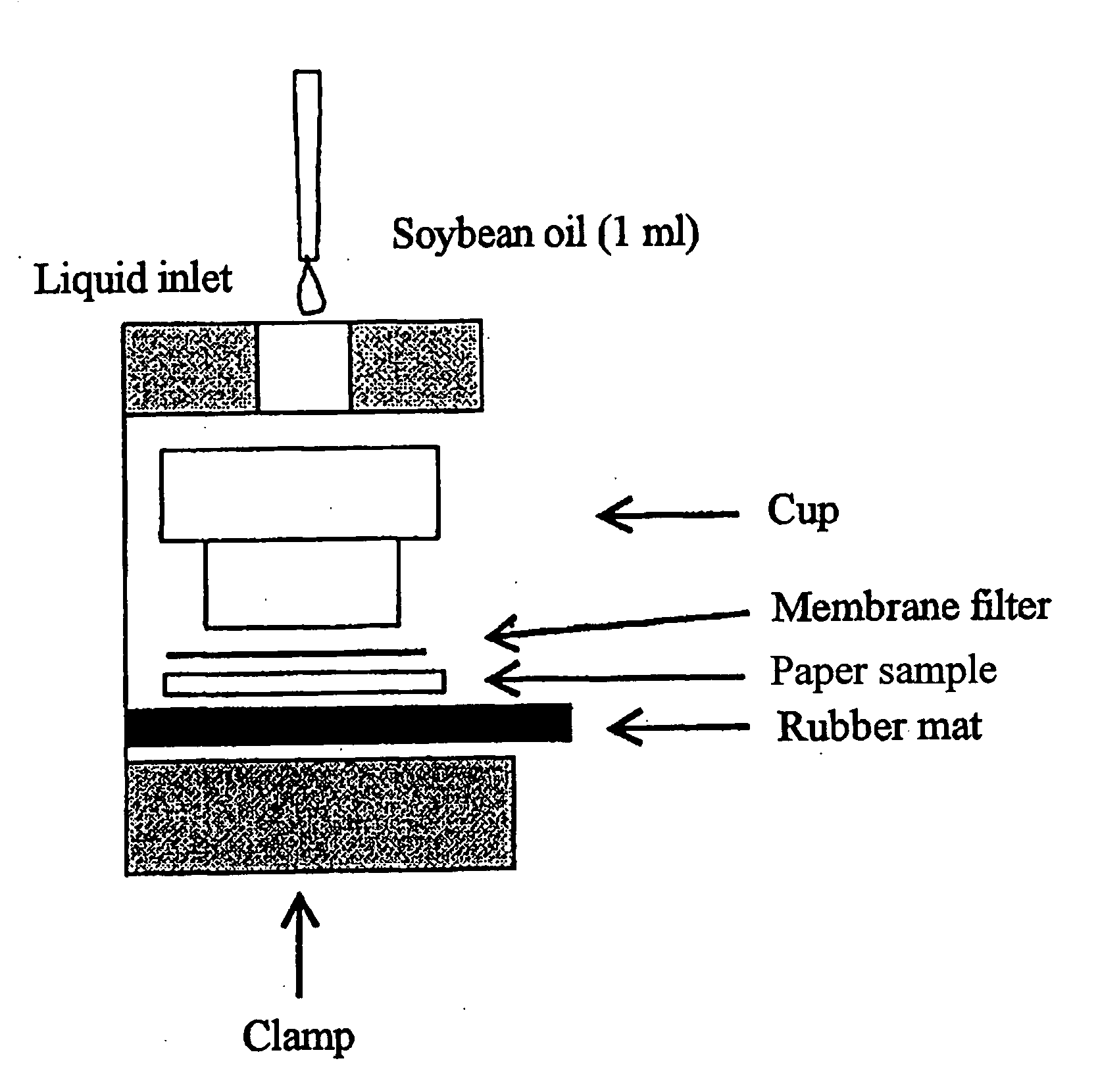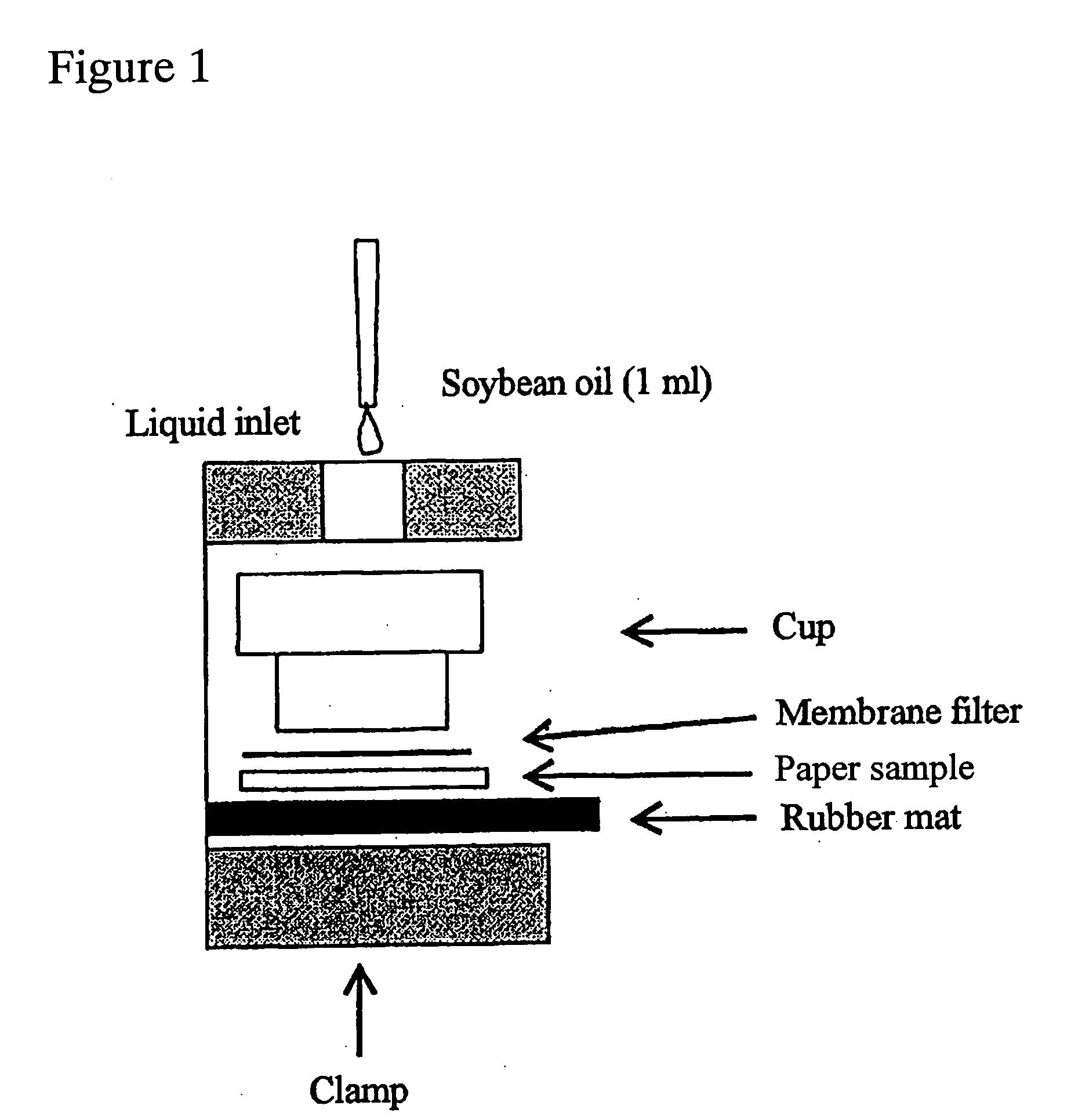Coated Papers for Newsprint Inks and Processes for Preparing Them
a technology of newsprint inks and coating papers, applied in the field of coating papers for newsprint inks, can solve the problems of poor color or sharpness of multicolor prints obtained under conventional newspaper printing conditions, inability to use high-speed coldset rotary presses, and inability to penetrate drying type inks, etc., to achieve good reproduction, reduce the density of the base paper layer, and fast ink drying properties
- Summary
- Abstract
- Description
- Claims
- Application Information
AI Technical Summary
Benefits of technology
Problems solved by technology
Method used
Image
Examples
example 1
[0045] A pigment consisting of 60 parts of fine ground calcium carbonate (FMT-90 from Fimatec Ltd.) and 40 parts of fine clay (JapanGloss from HUBER) was dispersed with a dispersant consisting of sodium polyacrylate in an amount of 0.2 parts based on the pigment in a Cellier mixer to prepare a pigment slurry having a solids content of 70%. Thus obtained pigment slurry was combined with 13 parts of a non-thickening styrene / butadiene latex (glass transition temperature 14° C.), 13 parts of a hydroxyethyl-etherified starch and water to give a coating color having a solids content of 48%. A wood-containing having a basis weight of 46 g / m2 and containing a pulp blend of 25% bleached chemical pulp, 45% mechanical pulp, and 30% deinked pulp with 0.4 parts by weight of an interfiber bonding inhibitor (KB-115 from Kao Corporation) per 100 parts by weight of the pulp was coated on both sides at a coat weight of 5.5 g / m2 per side using a blade coater at a coating speed of 620 m / min and then tr...
example 2
[0046] A pigment consisting of 40 parts of coarse-grained ground calcium carbonate (FMT-75 from Fimatec Ltd.) and 60 parts of second grade clay (DB-KOTE from Imerys Minerals Japan K.K.) was dispersed with a dispersant consisting of sodium polyacrylate in an amount of 0.2 parts based on the pigment in a Cellier mixer to prepare a pigment slurry having a solids content of 70%. Thus obtained pigment slurry was combined with 10 parts of a non-thickening styrene / butadiene latex (glass transition temperature 14° C.), 11 parts of a hydroxyethyl-etherified starch and water to give a coating color having a solids content of 54%. A coated paper was obtained by the same procedure as in Example 1 except that a wood-containing having a basis weight of 46 g / m2 and containing a pulp blend of 15% bleached chemical pulp, 45% mechanical pulp, and 40% deinked pulp without interfiber bonding inhibitor was coated at a coat weight of 6.5 g / m2 per side.
example 3
[0047] A pigment consisting of 60 parts of fine-grained ground calcium carbonate (FMT-90 from Fimatec Ltd.), 27 parts of second grade clay (DB-KOTE from Imerys Minerals Japan K.K.) and 13 parts of fine clay (JapanGloss from HUBER) was dispersed with a dispersant consisting of sodium polyacrylate in an amount of 0.2 parts based on the pigment in a Cellier mixer to prepare a pigment slurry having a solids content of 70%. Thus obtained pigment slurry was combined with 20 parts of a non-thickening styrene / butadiene latex (glass transition temperature 14° C.), 5 parts of a hydroxyethyl-etherified starch and water to give a coating color having a solids content of 54%. A wood-containing having a basis weight of 48 g / m2 and containing a pulp blend of 50% bleached chemical pulp, 40% mechanical pulp, and 10% deinked pulp with 5 parts of calcium carbonate as an internal filler and 0.6 parts by weight of an interfiber bonding inhibitor (KB-115 from Kao Corporation) per 100 parts by weight of t...
PUM
| Property | Measurement | Unit |
|---|---|---|
| Time | aaaaa | aaaaa |
| Pressure | aaaaa | aaaaa |
| Percent by mass | aaaaa | aaaaa |
Abstract
Description
Claims
Application Information
 Login to View More
Login to View More - R&D Engineer
- R&D Manager
- IP Professional
- Industry Leading Data Capabilities
- Powerful AI technology
- Patent DNA Extraction
Browse by: Latest US Patents, China's latest patents, Technical Efficacy Thesaurus, Application Domain, Technology Topic, Popular Technical Reports.
© 2024 PatSnap. All rights reserved.Legal|Privacy policy|Modern Slavery Act Transparency Statement|Sitemap|About US| Contact US: help@patsnap.com









